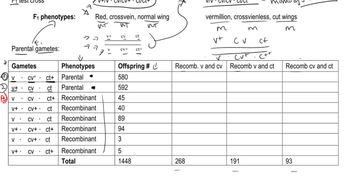Table of contents
- 1. Introduction to Genetics51m
- 2. Mendel's Laws of Inheritance3h 37m
- 3. Extensions to Mendelian Inheritance2h 41m
- 4. Genetic Mapping and Linkage2h 28m
- 5. Genetics of Bacteria and Viruses1h 21m
- 6. Chromosomal Variation1h 48m
- 7. DNA and Chromosome Structure56m
- 8. DNA Replication1h 10m
- 9. Mitosis and Meiosis1h 34m
- 10. Transcription1h 0m
- 11. Translation58m
- 12. Gene Regulation in Prokaryotes1h 19m
- 13. Gene Regulation in Eukaryotes44m
- 14. Genetic Control of Development44m
- 15. Genomes and Genomics1h 50m
- 16. Transposable Elements47m
- 17. Mutation, Repair, and Recombination1h 6m
- 18. Molecular Genetic Tools19m
- 19. Cancer Genetics29m
- 20. Quantitative Genetics1h 26m
- 21. Population Genetics50m
- 22. Evolutionary Genetics29m
4. Genetic Mapping and Linkage
Trihybrid Cross
Problem 23a
Textbook Question
Textbook QuestionA wild-type trihybrid soybean plant is crossed to a pure-breeding soybean plant with the recessive phenotypes pale leaf (l), oval seed (r), and short height (t). The results of the three-point test cross are shown below. Traits not listed are wild type. Phenotype Number Pale 648 Pale, oval 64 Pale, short 10 Pale, oval, short 102 Oval 6 Oval, short 618 Short 84 Wild type 98 1630 Calculate the interference value for these data.
 Verified Solution
Verified SolutionThis video solution was recommended by our tutors as helpful for the problem above
Video duration:
2mPlay a video:
Was this helpful?
Key Concepts
Here are the essential concepts you must grasp in order to answer the question correctly.
Trihybrid Cross
A trihybrid cross involves three pairs of contrasting traits, allowing the study of inheritance patterns for multiple genes simultaneously. In this case, the traits are leaf color, seed shape, and plant height. Understanding how these traits segregate and assort independently is crucial for analyzing the offspring's phenotypes and calculating genetic ratios.
Recommended video:
Guided course

Trihybrid Cross
Three-Point Test Cross
A three-point test cross is a genetic cross used to determine the arrangement of genes on a chromosome and the distances between them. By crossing a trihybrid organism with a homozygous recessive organism, the resulting offspring's phenotypes reveal information about gene linkage and recombination frequencies, which are essential for calculating genetic interference.
Recommended video:
Guided course

Trihybrid Cross
Genetic Interference
Genetic interference refers to the phenomenon where the occurrence of one crossover event in a region of a chromosome affects the likelihood of another crossover occurring nearby. It is quantified using the interference value, which can be calculated from the observed and expected double crossover frequencies. Understanding interference helps in mapping genes and understanding genetic linkage.
Recommended video:
Guided course

RNA Interference

 26:8m
26:8mWatch next
Master Trihybrid Cross with a bite sized video explanation from Kylia Goodner
Start learningRelated Videos
Related Practice

